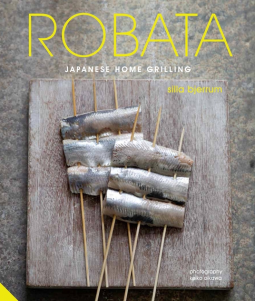
Robata
Japanese Home Grilling
by Silla Bjerrum
This title was previously available on NetGalley and is now archived.
Send NetGalley books directly to your Kindle or Kindle app
1
To read on a Kindle or Kindle app, please add kindle@netgalley.com as an approved email address to receive files in your Amazon account. Click here for step-by-step instructions.
2
Also find your Kindle email address within your Amazon account, and enter it here.
Pub Date 19 Apr 2018 | Archive Date 15 May 2018
Quarto Publishing Group - Jacqui Small | Jacqui Small
Talking about this book? Use #Robata #NetGalley. More hashtag tips!
Description
Marketing Plan
Campaign Focus:
London chef shares novel Asian fusion cuisine based on Japanese healthy home grilling and sustainable ingredients
Key Selling Points:
Yakitori-inspired recipes from London’s Kensington restaurant, Sushi and Robata
Robata is ‘fireside cooking’, Japanese style barbecued meat, fish and vegetables skewered and slow cooked to perfection
By a London chef trained in Tokyo, co-founder of Feng Sushi and Sushi and Robata, who has cooked at the James Beard House, and author of Simple Japanese
Key Campaign Activity
Longlead feature pitch to top food magazines
Review pitch to national print dailies
Feature pitch to top food sites and blogs
Pre-publication:
Giveaway at Eat Your Books, TASTE
Goodreads giveaway
Trade:
Review copies to Library Journal, Publishers Weekly, Shelf Awareness
Retail:
Consumer:
Video at QuartoKnows
Publicity/Media:
Longlead feature pitch to Bon Appetite, Cook’s Illustrated, Fine Cooking, Food Network Magazine, Food & Wine, Real Simple, Redbook, Sunset Magazine
Review copy push to top national newsprint food editors: Boston Globe, Chicago Tribune, Dallas Morning News, Los Angeles Times, Miami Herald, New York Times, San Francisco Chronicle, Wall Street Journal, Washington Post
Review copy push to top food and lifestyle sites: Buzzfeed, Eater, Epicurious, Food52, Food Republic, HuffPost, Leite’s Culinaria, theKitchen, SeriousEats, Yahoo Food, Yummly
Available Editions
| EDITION | Other Format |
| ISBN | 9781911127345 |
| PRICE | US$40.00 (USD) |
Average rating from 20 members
Featured Reviews
 Terry B, Reviewer
Terry B, Reviewer
“Robata” is a style of Japanese grilling that originated in Japan when fisherman would bring grills that were encased in stone onto their boats and cook their fresh catch onboard.
Now there are shichirin grills that are made of or clay that use different types of charcoal and sauces to grill meat, seafood and vegetables to tender perfection!
The grill cannot get wet, and the coals should be put in a metal bucket with water to cool down. The coals can be used for making an odor free refrigerator or for making rice fluffier.
You will learn how to take care of a robata grill, which tools to use with it, and of course, recipes to use with it, but you can use the recipes on any grill you own.
You will be using classic ingredients, such as wasabi and miso, along with a variety of seasonings to flavor your food.
In the first recipe, Large Blue Rope Mussel Shells with Miso Butter, you are told how to clean out the mussels and mix the miso butter, which is very helpful if you are not familiar with cooking seafood and using miso.
Another recipe, Sea Bream Fillet with summer pickles and Courgette (zucchini), gives you the specific steps in preparing the fish and pickles, and even some salsa, so that you have a delicious full meal.
There are also many steak, chicken and pork recipes, such as porterhouse steak with uni butter that are easy to make and look delicious!
There is a vegetarian recipe that sounds unique Robata Garden in Quinoa Soil that looks like the vegetables are in a pot of soil!
There are also salad, soup, yakitori and even dessert recipes such as Toasted Bincho Dust Marshmallows, the variety is endless -enjoy!
 Librarian 391714
Librarian 391714
While I'm not sure how many patrons would utilize this text, this is an excellent resource for Japanese Grilling. Not only does Bjerrum use both simple and advanced techniques in this text, but the recipes are unique and innovated.
 Melissa M, Reviewer
Melissa M, Reviewer
Robata is a stunningly beautiful cookbook. As a visual treat alone, Bjerrum’s book is delicious. After a detailed dive into the mechanics of Robata grilling, Bjerrum lays out the basic ingredients that are needed for this style of cooking. I’ll admit that the discussion of charcoal was a bit intimidating, but I was encouraged by the claim that the recipes will be delicious, even if we use more conventional grilling equpment. While the other ingredients can be somewhat harder to find, a well-stocked Japanese grocer will set you up.
If you are lucky enough to be able to source fresh fish, that chapter, with its inventive side dishes, are well worth the price of admission. I’ve tried only a few dishes from this cookbook (the Sea Bream Filet was terrific, and the side pickles a treat), but very much look forward to sampling more extensively. This is a cookbook to use, not just to read.
 KriisGaia S, Media/Journalist
KriisGaia S, Media/Journalist
Translated as “fireside cooking”, Robata is a Japanese style of grilling food. It pairs well with sushi to create the perfect combination of flavors and works well as a shared, communal food.
In the introduction, the author describes the History Of Robata, How To Cook Robata, Setting Up The Grill, even How To Create Your Own Robata Grill. Once your grill is set up you will want to review the tools recommended.
The key Japanese ingredients which will be used for the recipes are described, complete with pictures of many. The introduction also includes information on sourcing salmon sauces, cooking times etc.
The final section in the introduction covers How To Enjoy The Robata Meal. It gives you an overview of both the old-school and new modern Robata-styles.
The recipe categories cover:
Fish Robata
Other Robata
Classic Yakitori
Other Skewers
Nipples
Salads And Sides
Desserts And Drinks
Each recipe category begins with a brief description of the type of food found within. There are lots of pictures throughout the book, most of them with the label next to the dish complete with recipe name and page number. This will make it much easier to find the dish that visually appeals to you.
The recipes themselves each include a description and serving size. Most of the serving sizes mention the number of persons it makes as a main dish, as well as the number of dishes which should be included if it was served Robata style.
An Amazing Array Of Temptation
The glorious photography throughout the book will have you rushing to your grill in no time. The sheer variety of selection and unique flavor combinations mean nearly everyone will find something they absolutely love in this collection.
I must admit I cannot grill to save my life, nor can I say I’ve had much success with Japanese food in the past. That said, however, I find myself itching to try many of these recipes.
See the full review and the recipe for Asparagus Namban at The RecipesNow! Reviews And Recipes Magazine. This review is written in response to a complimentary copy of the book provided by the publisher in hopes of an honest review.
 Cassandra S, Reviewer
Cassandra S, Reviewer
A delicious Japanese cookbook, explaining the Robata style of fire-side cooking. The recipes looked mouth watering, and as soon as I have a backyard to cook in, I will certainly be buying myself a copy of this book in print, and I will be experimenting with these recipes all the time.
I have received a much appreciated digital copy of this book from NetGalley and the publisher in exchange for an honest review.
Robata translates into "fireside cooking" and is a Japanese style of grilling foods, served alongside raw and cooked dishes.
The book contains 8 chapters and begins with an Introduction which includes a history, how to cook robata style with how to setup a grill, tools and ingredients.
The are plenty of recipes to pick and choose from. There is a chapter on Fish Robata, and another on Other Robata, which includes sharing dishes using pork, beef, lamb and chicken which is great for a crowd.
Another chapter named Classic Yakitori translates as grilled bird using almost any part of a chicken - to prove this there is a recipe using the chicken heart included and looking at the photograph that accompanies it, you wouldn't know as it looks simply delicious.
A further chapter on Other Skewers includes more recipes using fish, vegetable and beef, These recipes are generally smaller portions.
To accompany the main dishes, this book covers Nibbles and Salads & Sides. Finally to finish off there is a chapter on Desserts and Drinks. Some of these dishes don't need to be grilled and are cooked on the stove or in a ordinary oven.
Each chapter includes wonderful colour photography, either next to the recipe or at the beginning of the chapter laid out as a full meal and each recipe has both metric and imperial measurements.
I received this book from netgalley in return for a honest review.
 Leyla J, Reviewer
Leyla J, Reviewer
This is a beautiful book, with very simple recipes which revolve around the use of a Robata grill - a Japanese charcoal traditional grill.
The layout, photographs and information in the book is superb - it makes a beautiful coffee table book. If you want to try making the food, the recipes are easy to follow, although some of the ingredients maybe challenging to find, Having said that, there are many recipes that have simple ingredients and can be tried at home on a charcoal grill, instructions on how to make a DIY Robata grill is provided.
I love this book it offers pure fresh food with beautiful flavours
 Karen H, Reviewer
Karen H, Reviewer
Robata: Japanese Home Grilling by Silla Bjerrum, is not your everyday grilling cookbook. It is, in fact, very different, and will appeal to those who love Japanese food and culture. The book includes chapters on the history of robata, how to cook robata at home, and how to eat robata, and the ingredients needed to make the dishes.
Even though this book features an excellent chapter on ingredients, some of the ingredients are difficult to find, and the author has not offered substitutions for those who can’t find them. For instance, Okonomiyaki flour, and yuzu juice. I have two huge Asian grocery stores near me, and although one or the other have always had what I needed, yuzu juice or powdered yuzu was not to be found; the okonomiyaki flour was carried at both stores, so I was able to make one of the delicious dishes - Okonomiyaki Masquerading as Prawn (Shrimp) Toast, which was worth searching for the flour. I had to order several ingredients online, including the yuzu products. In the meantime, I prepared the Chilean Sea Bass with Choy Sum (available at the Asian grocery) and Onion Relish, and it was delicious. Actually every recipe in the book that I have tried so far has been delicious.
The word “appetizing” is relative, and chunks of skin-on fish and fish with heads do not fall into that category in most American households. Those of us who have spent some time in Japan know that the cultures are very different, and what is mouthwatering to the Japanese isn’t always mouthwatering to the Americans. That said, however, doesn’t make the recipes unappetizing; they are simply unique, and many are absolutely luscious. Recipes in my queue so far are Salmon Smoked on Yuzu Leaves, Rib Eye with Wasabi, Baby Back Pork Ribs, and Yuzu Chicken. There are dozens of recipes that are worth making. The recipe directions are succinct and easy to understand, and many of the dishes are pictured – it would be better if all were pictured since the dishes are quite foreign.
All told, this is a very unique cookbook for grilling enthusiasts. The book makes it possible to bring a bit of Japan into American homes, and that will make for a good summer of non-boring grilling.
Special thanks to NetGalley for supplying a review copy of this book.
 Lili F, Reviewer
Lili F, Reviewer
This book is delightful if you like Japanese cuisine, doubly so if you are light on space and a full sized grill is not really in the works for you! Filled with clear instructions on how to set up the grill and easy to understand recipes, you get an excellent cookbook. The food looks delicious and the yuzu chicken has my mouthwatering...now if only I can find a good source of local yuzu!
 Alina M, Reviewer
Alina M, Reviewer
I was lucky enough to receive a free copy by of this book via netgalley! I loved it very much and I'm looking forward to try some of these recipes!
 Reviewer 446033
Reviewer 446033
#Robata #NetGalley #Japan #Grill #Summer2018
Silla provides us with rich and authentic recipes of this culinary art which is the Robata. The collection includes step by step recipes for the main meal, drinks, appetizers, and others. Delicious!
 Bookseller 431166
Bookseller 431166
The pictures were beautiful and the variety of recipes is more than satisfying. They are also not too complex although some of the ingredients might not be readily available if someone doesn't know where to look. Overall, I'm excited to try more of these recipes out.






